Chapter: Mechanical and Electrical : Thermal Engineering : Air Compressors
Air Compressors
AIR COMPRESSORS
PREREQUISITE DISCUSSION
A history associated with air compressors like a
device goes back in order to antiquity.
Guy offers utilized
compressors data compression with regard to a large number of many years in
order to warmth their house, prepare meals, as well as proceed items. The first
kind of compressor had been the bellows accustomed to great time compacted compressors
on to the fireplace. These types of easy compressing models had been possibly
driven through guy or even creatures in order to shrink. They were changed
through mechanized air compressors that have been employed for commercial
reasons. Along with improvements within technology, compressors had been
decreased in dimensions as well as discovered utilizes beyond industrial
facilities because helps with regard to marine scuba diving in order to energy
pneumatic resources as well as exercises.
CONCEPT OF AIR COMPRESSOR
Introduction:
Ø The
process of increasing the pressure of air, gas or vapour by reducing its volume
is what compression.
Ø The
devise used to carry out this process is called a compressor.
Principles on which compressors work:
Ø A compressor
is a mechanical device that increases the pressure of a gas by
reducing its volume.
Ø Compressor
is a machine which increases the pressure of a fluid by mechanically decreasing
its volume (i.e. by compressing it).(The fluid here is generally air since
liquids are theoretically incompressible).
Construction:
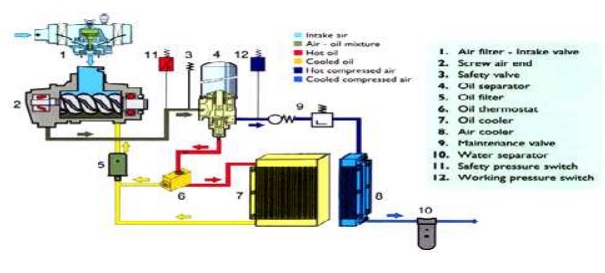
SIGNIFICANCE OF AIR COMPRESSORS
Ø Compressed
Air is often described as the fourth utility, although not as ubiquitous as electricity, petrol and gas,
it plays a fundamental part in the modern world.
Ø The
importance of compressed air is often over looked, but in reality it plays a
vital part in most modern manufacturing processes and modern civilization.
Ø Although
we may not realize it most products we use today could simply not be made
without compressed air.
Ø Compressed
air accounts for about 10% of the global energy used in industry today.
Ø With so
many applications in different environments being dependant on compressed air,
the compressors not only have to compress the air to a specific pressure, at a
certain flow, it has to deliver air of the right quality.
Ø To most
people, a compressor is all that is required to compress air, but to obtain the
right quality of the compressed air, more equipment is often needed.
Ø Filters
and dryers are often needed to remove oil and water before it reaches the
application.
Ø Compressed
Air has a range of completely oil-less compressors where air comes into contact
with the process it serves and so the quality is critical, for example in where
a compressor may be used in a food packaging role.
CLASSIFICATION OF AIR COMPRESSORS
Types of compressors
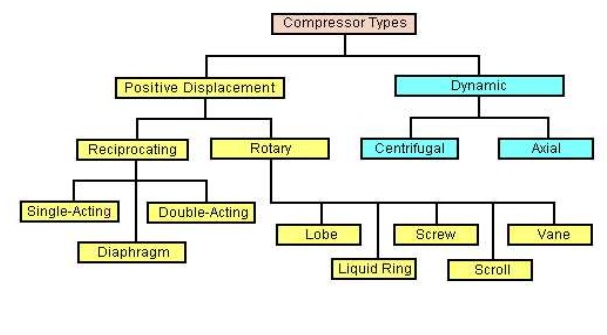
Positive displacement compressor
Ø In the
positive-displacement type, a given quantity of air or gas is trapped in a
compression chamber and the volume it occupies is mechanically reduced, causing
a corresponding rise in pressure prior to discharge.
Ø At
constant speed, the air flow remains essentially constant with variations in
discharge pressure.
Ø Ex:
Reciprocating compressors, vane
compressors & so on.
Dynamic compressors:
Ø Dynamic
compressors impart velocity energy to continuously flowing air or gas by means
of impellers rotating at very high speeds.
Ø The
velocity energy is changed into pressure energy both by the impellers and the
discharge volutes or diffusers.
Ø In the
centrifugal-type dynamic compressors, the shape of the impeller blades
determines the relationship between air flow and the pressure (or head)
generate.
Ø Ex:
centrifugal compressors, axial compressors.
Reciprocating compressors
Ø In a
reciprocating compressor, a volume of gas is drawn into a cylinder; it is
trapped and compressed by piston, then discharged into the discharge line.
Ø The
cylinder valves control the flow of gas through the cylinder; these valves act
as check valves.
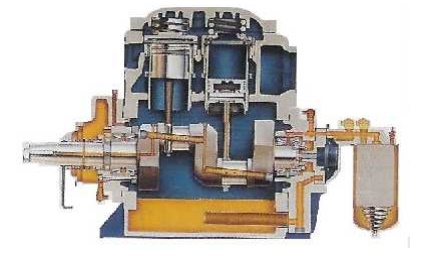
Principle
of Operation
Ø The
piston is driven by a crank shaft via a connecting rod.
Ø At the
top of the cylinder are a suction valve and a discharge valve.
Ø A
reciprocating compres sor usually has two, three, four, or six cylinders in it.
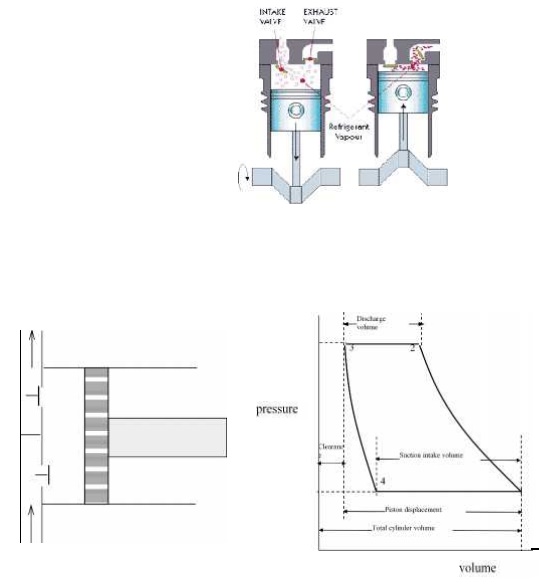
Ø The
suction valve opens at point 4.
Ø As the
piston travels toward the bottom dead center, the volume of the c ylinder
increases and the vapor flows into the cylinder.
Ø The
pressure inside the cylinder is slightly less than suction line pressu re. The
pressure difference pushes the val ve open on during the suction stroke.
Ø At point
2, the pressure inside the cylinder has become slightly greater than discharge
line pressure.
Ø This
causes the valve opening allowing the gas to flow out of the cylinder.
Ø The
volume continues to decrease toward point 3, maintaining a sufficient pressure
difference across the discharge valve to hold it open.
Ø At point
3, the piston reaches the top dead center and reverses direction.
Ø At top
dead center, as the piston comes to a complete stop prior to reversing
direction, the pressure across the valve is equal.
Ø So, the
discharge valve is closed.
Ø As the
piston moves towards point 4, the volume increases and the pressure decreases
in the cylinder.
Ø The gas
trapped in the cylinder expands as the volume increases until to point 4.
Ø At point
4, the gas pressure inside the cylinder becomes less than the suction line
pressure, so the suction valve opens again.
Ø The cycle
then starts over again.
Ø The shape
of the re-expansion line (Line 3-4) is dependent on the same compression
exponent that determines the shape of the compression line.
What is the difference between a
single and two stage compressor?
Ø The simplest way to explain the difference between a single
stage compressor and dual or two stage compressor is the number of times that
the air is compressed. In a single stage system the air is compressed once and
in a dual stage the air is compressed twice.
Ø In a single stage piston compressor the air is drawn into a
cylinder and compressed in a single piston stoke to a pressure of approximately
120 PSI. Then it is send to the storage tank. All rotary compressors are single
stage.
Ø In a dual stage compressor the first step is the same except
that the air is not directed to the storage tank, the air is sent via an inter
cooler tube to a second, smaller high pressure piston and compressed a second
time and compressed to a pressure of 175 PSI. Then it is sent through the after
cooler to the storage tank.
Ø In a dual stage pump the first stage cylinder is always a larger
diameter. Also a dual stage pump will always have an inter cooler tube or
finned housing attached to the pump to cool the air before being compressed a
second time.
ROTARY VANE COMPRESSORS
Rotary
vane compressors consist of a rotor with a number of blades
inserted in radial slots in the rotor.
Ø The rotor is mounted offset in a larger housing that is either
circular or a more complex shape. As
the rotor turns, blades slide in and out of the slots keeping contact with the
outer wall of the housing. Thus, a series of decreasing volumes is created by
the rotating blades.
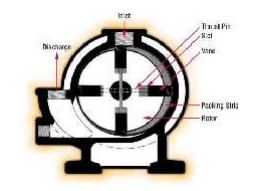
MULTISTAGE COMPRESSION:
Multistage
compression refers to the compression process completed in more than one stage
i.e., a part of compression occurs in one cylinder and subsequently compressed
air is sent to subsequent cylinders for further compression. In case it is
desired to increase the compression ratio of compressor then multi-stage
compression becomes inevitable. If we look at the expression for volumetric
efficiency then it shows that the volumetric efficiency decreases with increase
in pressure ratio. This aspect can also be explained using p-V representation
shown in Figure.
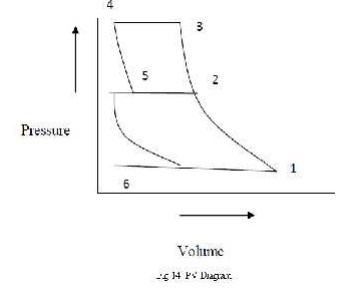
A
multi-stage compressor is one in which there are several cylinders of different
diameters. The intake of air in the first stage gets compressed and then it is
passed over a cooler to achieve a temperature very close to ambient air. This
cooled air is passed to the intermediate stage where it is again getting
compressed and heated. This air is again passed over a cooler to achieve a
temperature as close to ambient as possible. Then this compressed air is passed
to the final or the third stage of the air compressor where it is compressed to
the required pressure and delivered to the air receiver after cooling
sufficiently in an after-cooler.
Advantages
of Multi-stage compression:
The work done in compressing the air is reduced, thus power
can be saved
2. Prevents mechanical problems as the air temperature is
controlled
3. The suction and delivery valves remain in cleaner condition
as the temperature and vaporization of lubricating oil is less
4. The
machine is smaller and better balanced
5. Effects
from moisture can be handled better, by draining at each stage
6.
Compression approaches near isothermal
7. Compression
ratio at each stage is lower when compared to a single-stage machine
WORK DONE IN A SINGLE STAGE
RECIPROCATING COMPRESSOR WITH CLEARANCE VOLUME:
Considering clearance volume: With clearance volume the cycle
is represented on Figure. The work done for compression of air polytropically
can be given by the are a enclosed in cycle 1-2-
3-4.
Clearance volume in compressors varies from 1.5% to 35% depending upon type of
compressor.
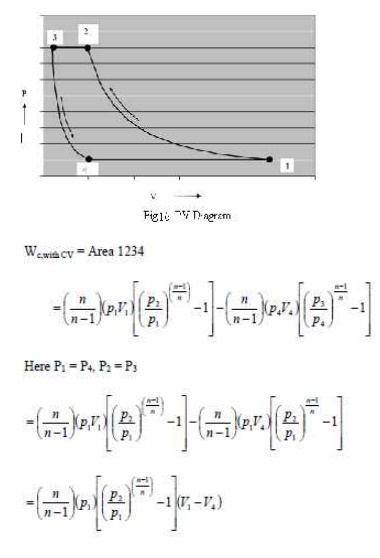
In the
cylinder of reciprocating compressor (V1-V4) shall be the actual volume of air
delivered per cycle. Vd = V1 – V4. This (V1 – V4) is
actually the volume of air in hated in the cycle and delivered subsequently.

If air is
considered to behave as perfect gas then pressure, temperature, volume and mass
can be inter related using perfect gas equation. The mass at state 1 may be
given as m1 mass at state 2 shall be m1, but at state 3 after delivery mass
reduces to m2 and at state 4 it shall be m2.
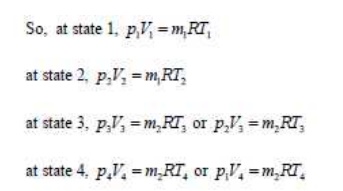
Ideally
there shall be no change in temperature during suction and delivery i.e., T4 =
T1 and T2 = T3 from earlier equation
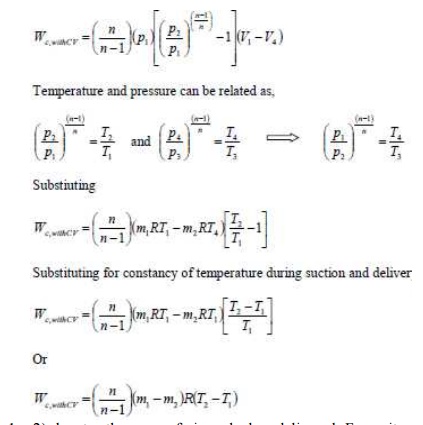
Thus
(m1-m2) denotes the mass of air sucked or delivered. For unit mass of air
delivered the work done per kg of air can be given as,

Thus from above expressions it is
obvious that the clearance volume reduces the effective swept volume i.e., the
mass of air handled but the work done per kg of air delivered remains
unaffected. From the cycle work estimated as above the theoretical power required
for running compressor shall be,
For
single acting compressor running with N rpm, power input required, assuming
clearance volume.
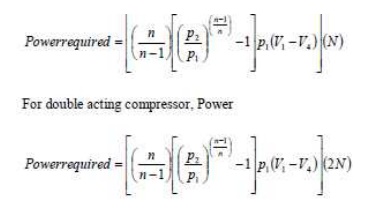
VOLUMETRIC EFFICIENCY:
Volumetric
efficiency of compressor is the measure of the deviation from volume handling
capacity of compressor. Mathematically, the volumetric efficiency is given by
the ratio of actual volume of air sucked and swept volume of cylinder. Ideally
the volume of air sucked should be equal to the swept volume of cylinder, but it
is not so in actual case. Practically the volumetric efficiency lies between 60
to 90%. Volumetric efficiency can be overall volumetric efficiency and absolute
volumetric efficiency as given below.
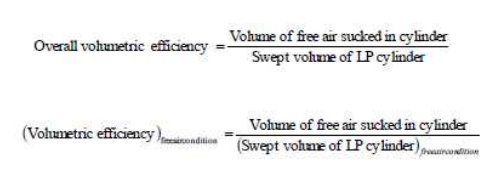
Here free air condition refers to the standard
conditions. Free air condition may be taken as 1 atm or 1.01325 bar and 15oC or
288K. consideration for free air is necessary as otherwise the different
compressors can not be compared using volumetric efficiency because specific
volume or density of air varies with altitude. It may be seen that a compressor
at datum level (sea level) shall deliver large mass than the same compressor at
high altitude. This concept is used for giving the capacity of compressor in
terms of „free air
delivery‟(FAD). “Free air
delivery is the volume of air delivered being reduced to free air conditions”. In case
of air the free air delivery can be obtained using perfect gas equation as,

Where subscript a or pa, Va, Ta denote properties at free air
conditions

This volume Va gives „free air
delivered‟per cycle by the compressor. Absolute
volumetric efficiency can be defined, using NTP conditions in place of free air
conditions.
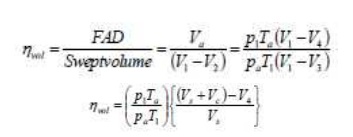
Here Vs is the swept volume = V1 – V3 and
Vc is the clearance volume = V3

Volumetric efficiency depends on
ambient pressure and temperature, suction pressure and temperature, ratio of
clearance to swept volume, and pressure limits. Volumetric efficiency increases
with decrease in pressure ratio in compressor.
Mathematical analysis of multistage compressor is
done with following assumptions:
(i) Compression
in all the stages is done following same index of compression and there is no
pressure drop in suction and delivery pressures in each stage. Suction and
delivery pressure remains constant in the stages.
(ii) There
is perfect inter
cooling between compression
stages.
(iii) Mass handled in different
stages is same i.e., mass of air in LP and HP stages are same. (iv) Air behaves
as perfect gas during compression.
From combined p-V diagram the compressor work requirement can
be given as,
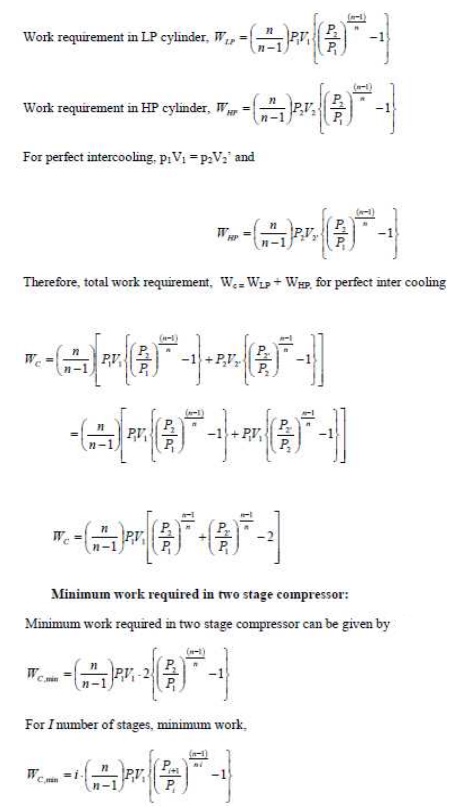
APPLICATION OF COMPRESSORS
Ø Reciprocating
compressors are typically used where high compression ratios (ratio of
discharge to suction pressures) are required per stage without high flow rates,
and the process fluid is relatively dry.
Ø Screw
compressors: Trailer mounted diesel powered units are often seen at
construction sites, and are used to power air operated construction machinery.
Ø P.E.T
bottling industries, gas filling stations usually use reciprocating
compressors.
Ø Processing
equipment, Oxygen Generators Oil Atomization use compressors of required
capacity.
Ø Air
compressors: a compressor that takes in air at atmospheric pressure and
delivers it at a higher pressure.
Ø Compressors
serve the basic necessities & form an integral part of the company .
Ø Pneumatic
brakes
Ø Pneumatic
drills
Ø Pneumatic
jacks
Ø Pneumatic
lifts
Ø Spray
painting
Ø Shop
cleaning
Ø Injecting
fuel in Diesel engines
Ø Refrigeration
and Air conditioning systems.
Related Topics